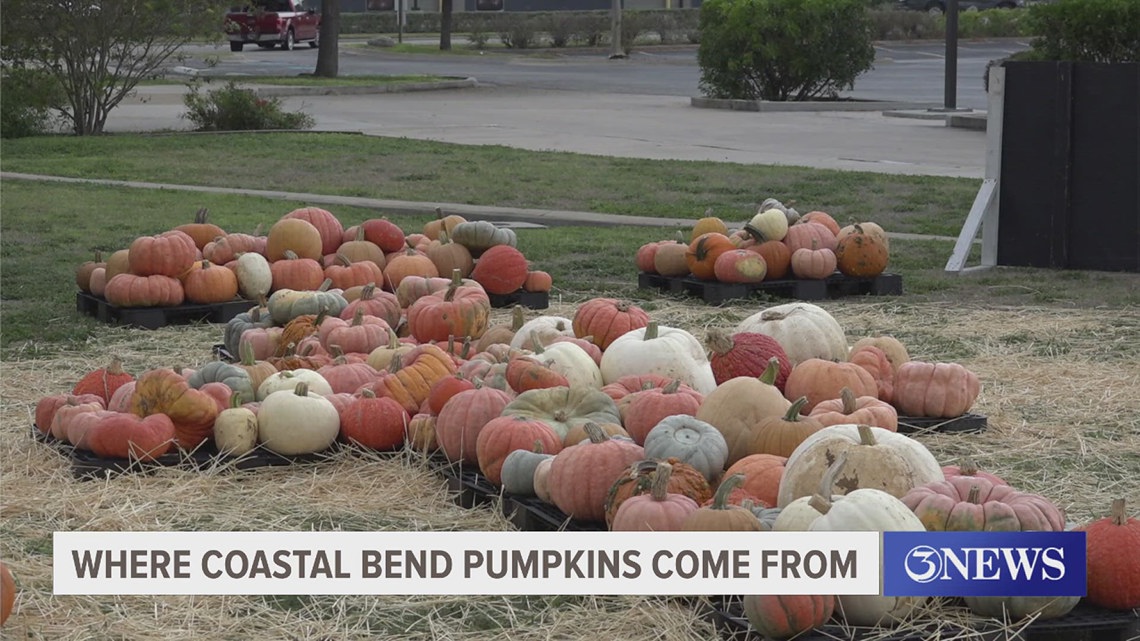Every year pumpkins travel down to the Coastal Bend from areas with more favorable weather conditions for pumpkin growth
CORPUS CHRISTI, Texas — In October, pumpkin patches begin popping up around the Coastal Bend. Many residents may wonder: where do all these pumpkins come from?
It turns out, the journey of a pumpkin is longer than you might expect.
“So, we go through Pumpkins USA, which is a distributor that’s based out of New Mexico in the desert there, and they work with the Navajo reservation there to help get jobs for them,” said Brandy Hernandez, pumpkin patch manager at Grace United Methodist Church.
Although pumpkins are grown in Texas, about 90% of them are produced in West Texas, according to the Texas A&M AgriLife Extension.
What Makes West Texas Better for Pumpkins?
The key difference is humidity.
“Our area is drier than your area, humidity-wise. And it creates less issues in the growth of the pumpkin,” said Tim Assiter of Assiter Pumpkin Ranch in Floydada, Texas.
Pumpkins don’t do well sitting in moisture. High humidity or standing water can cause mildew and stains, making the pumpkins less visually appealing and more prone to rot. While pumpkins are technically a desert crop, they still need rainfall — striking the right balance is critical.
“Our rainfall is usually 12 to 16 inches per year. It’s not an awful lot. And when that happens, we normally do not have the kind of yield that we have. And the hotter it stays, the smaller the pumpkins stay. This year we’ve been blessed with a great big, beautiful pumpkin. We’ve got the prettiest jack-o’lanterns that we have ever raised, and that we’ve been raising pumpkins since the 1960s,” Assiter said.
Coastal Bend Conditions Aren’t Ideal
In Corpus Christi, the average annual rainfall is around 31 inches, and the humidity is especially high during the summer. The primary crops grown here — cotton, corn, and sorghum — rely heavily on the timing of that rainfall.
“All three of those I just mentioned are summer crops that we would plant starting in February through the end of March. Then about the time those crops get to a stage where they’re big enough they need a lot of water, that spring rain comes. Then we also need hot dry weather at harvest so that typical summer drought is actually a good thing when we’re harvesting grain and cotton,” said Dr. Josh McGinty, associate professor and extension agronomist with Texas A&M.
Could Pumpkins Grow Here?
Despite the climate, growing pumpkins in the Coastal Bend is possible — but not easy.
“Everything that we have is harvested by hand, and we have to bring people up from other areas that are willing to bend over and pick those things up, put them in a trailer, and then wash them and then put them down in those boxes,” Assiter explained.
Luckily, You Don’t Have to Grow Your Own
Many churches — including Grace United Methodist — offer already harvested pumpkins to local families, saving them the work and offering a festive way to celebrate the season.
So, whether your pumpkins come from West Texas or a New Mexico distributor working with the Navajo Nation, you can enjoy them knowing they’ve traveled a long way to brighten your doorstep.

